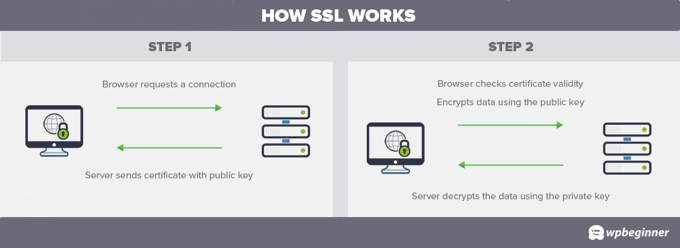HTTP stands for Hypertext Transfer Protocol. Every web address starts with HTTP or HTTPS, indicating to your web browser which protocol to use when accessing a website.
When you attempt to visit a site, your browser sends a GET request to the web server, which then returns the files associated with that specific domain name to your device.
While the underlying mechanisms can be quite technical, our goal is to simplify the explanation.
From 1999 to 2015, HTTP/1.1 was the primary protocol used for browsing the World Wide Web. In 2015, HTTP/2 was introduced, resulting in significant improvements in authentication, DNS queries, and the overall handling of routing and caching for HTML files.
For more details, check out our guide on HTTP/2 and how to implement it on your WordPress site.
How Does HTTP Work?
When you enter a website address (URL) in your browser and press ‘Enter,’ your browser initiates an HTTP request to the site’s web server, essentially asking, ‘Could I please access this web page?’ Next, the hosting server receives your request, verifies its authentication, and responds with what is known as an HTTP response.
This response contains the content of the web page, including HTML, CSS, text, images, and videos. Lastly, your browser gets the server’s response, processes it, and compiles everything to display the complete web page.
By optimizing your site according to factors like Google’s Core Web Vitals, you can influence the sequence in which the server delivers content to the browser, as well as provide guidance on how the browser should process and load that content.
HTTP and Security: HTTP vs. HTTPS
By default, HTTP is not secure; it operates as a straightforward request-and-response mechanism. During the transfer of information, it can be intercepted by anyone who knows how to access it—usually through malware, so there’s generally no need to be alarmed.
Nonetheless, the majority of websites today utilize an SSL (Secure Sockets Layer) certificate, which encrypts the data exchanged between you and the website.

In this instance, the “HTTP://” prefix in the web address will be swapped for “HTTPS://,” denoting the secure variant of HTTP.
The protocol that provides security for the majority of servers and web applications is known as TLS, or Transport Layer Security.
This is a more sophisticated protocol, and your website likely employs TLS rather than traditional SSL. Since “SSL” has become a widely recognized term, it is frequently used interchangeably with TLS.
HTTP Codes and Errors
Because HTTP is at the core of how the internet works, there may be a server error when someone attempts to reach your site. These are the most common HTTP errors:
- 500 (internal server error) – The site’s web server is experiencing an unknown technical difficulty.
- 403 (forbidden) – You don’t have access to the resource you requested.
- 404 (page not found) – The page has moved, doesn’t exist, or the URL is incorrect.
You may encounter various HTTP errors, and we’ve compiled a summary of the most prevalent WordPress errors along with their solutions.
We trust this article has clarified what HTTP is and how it functions. Additionally, check out our Additional Reading section below for more articles featuring helpful WordPress tips, tricks, and ideas.
If you found this article useful, consider subscribing to our YouTube Channel for WordPress video tutorials. You can also connect with us on Twitter and Facebook.


